Considering and Supporting Difference
An Interview with Jess Lowe at One Dance UK about “Considering Difference – Making Dance Accessible”
BY EMMALY WIEDERHOLT; ILLUSTRATIONS BY DANI BOWER COURTESY ONE DANCE UK
Jess Lowe is the Dancers’ Health, Wellbeing, and Performance Administrator at One Dance UK, the sector support organization for dance in the United Kingdom. Along with her colleagues Erin Sanchez, Katie Stevens, and Barny Darnell, Jess recently helped create “Considering Difference – Making Dance Accessible,” a resource that seeks to bring awareness to access barriers in dance spaces, and to suggest actions that promote independence and inclusion. Here, Jess shares the impetus and process of putting the initiative together, as well as her personal takeaways from working on the project.
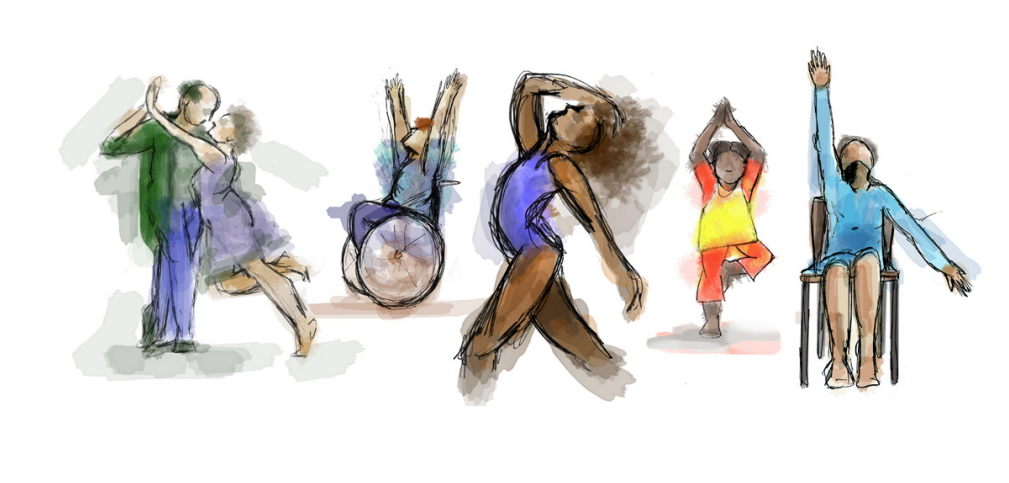
Image description: A row of illustrations of dancers in different poses, included (L-R) a couple doing ballroom dance, a wheelchair dancer with raised arms, a dancer in a leotard with their hand touching their head, a dancer in a yoga pose, and a dancer sitting in a chair with one arm extended overhead.
~~
Can you first share a little about your own dance history, how you became involved with One Dance UK, and why you felt drawn to work on “Considering Difference”?
As goes the tale familiar to many of us, I am a dancer turned dance-sector worker, having been dealt the hand of chronic injury. Prior, I trained primarily in jazz, Latin American ballroom, Limón, release, and aerial acrobatics. I did that from pre-professional training to post-graduate level practice.
It’s thanks to my experiences of injury that sparked my interest in all the implications associated with it, and my amazement of the body grew and grew from there. The more injuries I incurred, the more I became interested in things like injury origin and causation, by-products of injury, and other related individual and pedagogical components that may affect not only a dancer’s physical health, but their mental and emotional health, and their subsequent ability to perform at their best.
I kept these curiosities close by throughout my training and career. Following my undergraduate degree where I studied at the University of Roehampton in London as well as at Macquarie University in Sydney, I was inspired to complete my MSc in Dance Science at Trinity Laban Conservatoire of Music and Dance where I spent dedicated time unpicking these interests further. And it was as I was doing so that – thanks to a series of assessments following a suspicion I had – I was diagnosed with Developmental Coordination Disorder (or DCD).
This was the biggest lightbulb moment for me: my world, particularly my dancing world and my world as a dance student, finally made sense. It was the missing piece of the puzzle. The insecurities, the inner undeniable sense of difference that I felt, the difficulty picking up and remembering phrases and material, and in part the injuries; it all became logical, and from that moment on I stopped resenting myself for feeling inadequate in what I bought to dance. It was as though I was able to adopt this sense of acceptance and newfound excitement in this neurodiverse characteristic of my identity. I felt proud to be a dyspraxic dancer and learner. I then went on to write my master’s thesis about the cognitive learning styles of dancers with specific learning differences in vocational dance settings.
I’m incredibly thankful for these experiences because they brought me to where I am now in my career, which is essentially sandwiched somewhere between dancers’ health, wellbeing and science, and an innate feeling of responsibility towards equitable dance access. This includes accommodating and celebrating the differences we each bring to dance. I am so fortunate that my role at One Dance UK encompasses and advocates for each of these elements.
“Considering Difference – Making Dance Accessible” is a culmination of not only my interests and experiences, but also those of my colleagues at One Dance UK: Erin Sanchez (our manager of Health, Wellbeing and Performance), Katie Stevens (our Operations Manager), and Barny Darnell (our Membership Manager). They all collectively bring a wealth of knowledge to this initiative. Together, this is an area of work that we are well-versed in and well-equipped to discuss, and feel incredibly passionate about. We want to put that passion and knowledge to good use and invite the sector to be thinking about these things with us.
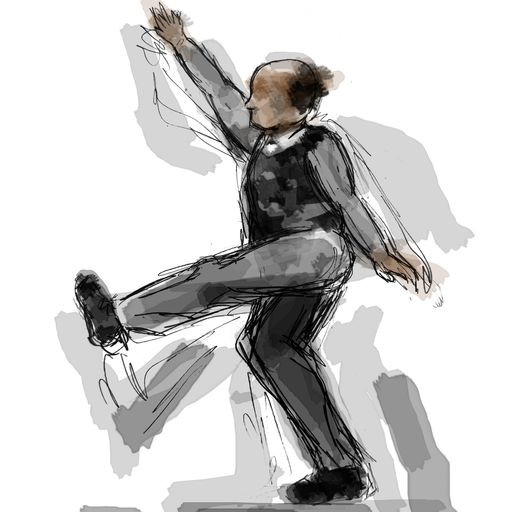
Image description: An illustration of a dancer lifting one leg and one arm in front of them.
How did “Considering Difference” come about? Was there a particular impetus that got the ball rolling?
I love this question because I think the origin stories of endeavors like these are important; knowing who is behind them and the intentions behind them speaks volumes about the authenticity of interest and the intended impacts of the project.
“Considering Difference” came about as a result of a couple things. Firstly, it had to do with the recognition that we as a collective group of staff at One Dance UK had a keen understanding of the subject area from a variety of perspectives, and were actively seeking ways in which we could pool our knowledge, resources, and networks to channel it in a way that could be valuable to the sector.
Secondly, as the sector support organization for dance within the UK, we had previously been challenged to define our stance on access and inclusion and to develop a sort of mission statement around that. The project grew out of actioning that challenge by molding together our existing ideas, connections, and research into something that could become greater than the sum of its parts.
What was the process of creating “Considering Difference”? Was there anything that was unexpected about the process?
The process from concept to completion took place from Spring 2020 to Spring 2022 and it followed a practice-as-research approach. I suppose the most unexpected part of the process was COVID, which of course delayed us. But that aside, we started by carrying out a rapid review of evidence, which indicated to us a somewhat limited availability of resources about inclusive and accessible dance spaces that was specifically targeted toward dance venues. To our knowledge at the time, there were very few free-to-access, relevant resources available to guide and support venues in creating more accessible and inclusive dance environments. We did come across literature focusing on national legislation and policy, but this was largely presented through the lens of the medical model, and rarely was there a direct focus on dance per se. Information that we found was more generalized around venues that hosted sporting activities, for instance.
From there we were keen to understand how this gap in information was impacting the dance field at ground level, so we took key questions that had come up for us through this literature review process directly to the sector through semi-structured interviews. We asked 28 members of the dance sector with a lived experience of an access need their thoughts around key issues. This involved asking them questions such as, “What do you think dance spaces and venues should consider to be more accessible?” and “What considerations do you think should be priorities?” For some, this was around larger infrastructural changes, and for others this was to do with social expectations or enhancing general awareness. This helped us to gather a breadth of insight from a range of people working in dance: dancers, teachers, administrators, choreographers, company directors, venue staff, course leaders, and other stake holders. Their responses were mind-blowingly momentous for us.
At this point I think it’s important to mention that the term ‘difference’ in the way that it’s applied here is limitless. It encompasses members of our sector who expressed a sense of difference or having worked with somebody with a sense of difference based on their physicality, mental health, learning preferences, age, gender, caring responsibilities, religion, economic status, or any combination of these. The perspectives and accounts of lived experiences that we gained from this interview process were hugely diverse, both in terms of representation of roles and representation of difference or access needs.
In terms of sampling, we reached out to people we knew amongst our networks who were already active in and around this area of work and who were willing to contribute their thoughts and ideas. We wanted to get as broad a range of perspectives as possible. We were willing to listen to anyone who was willing to talk with us about their perception of difference. Who were we to say what difference is and how it’s embodied? I suppose we may think of difference as existing on a spectrum. There’s difference in extremes; somebody who needs infrastructural support to accommodate their difference is going to have a different experience than someone who might require a safe space or a quiet room that already exists in a venue. That’s just one example. We wanted to collect as many perspectives as we could.
I suppose one of the things that surprised us was how challenging it was just for us to define what we meant by the term ‘difference.’ We wanted to be clear that everybody will experience and understand difference differently, but of course when trying to define difference comes the issue of inadvertently creating a duality between that which is or isn’t ‘normal.’ We contemplated that throughout the process, and in the end, it became more about getting across our desire to encourage people to just get thinking about a variety of considerations, regardless of what difference might mean or how it might look.
Once we’d collected all the responses from participants, we carried out inductive thematic analysis, followed by a process of member-checking which took place via focus groups. These focus groups also served as opportunities for us to gain feedback from the participants about how the work was developing, to hone in on recurring areas of dialogue and discourse, to field questions which helped us to improve the clarity of our intention, aims, and content, and to inform our next steps. Albeit quite daunting, this was a fruitful step along the process.
At this point we took some time to review and evaluate all that had taken place so far – the processes we had followed, the interactions we’d had, the feedback we had received, the themes and findings we had gathered – and we used all that to compile an action strategy to guide us toward creating an academic research presentation about “Considering Difference,” which we presented at the International Association of Dance Medicine and Science Conference (or IADMS) in Denver, Colorado in 2021. This stage was pivotal to the work because it not only enabled us to establish an academic output that spoke to different sector audiences and was grounded in fundamental principles of dance science, but it also enabled us to share our work with and invite interrogation from a renowned community of professionals. This enhanced the credibility of the work.
The final step in the process was to translate all that we had gathered and learned into an information sheet that the sector could tangibly pick up and use to help them in their practice. We sought feedback on iteration after iteration of the resources that we were creating from our group of external contributors and participants, as well as from the internal One Dance UK staff with large amounts of input from our brilliant communications teams who we have to thank for the final design. We also consulted other design experts who specialize in creating accessible resources to help us adjust the language and structure of the content itself to translate into an easier-to-read format.
At this point, we were aware that the last thing we wanted was to have created an information sheet about access that wasn’t accessible! This encouraged us to investigate other ways in which the information might be presented that could suit a broader range of audiences.
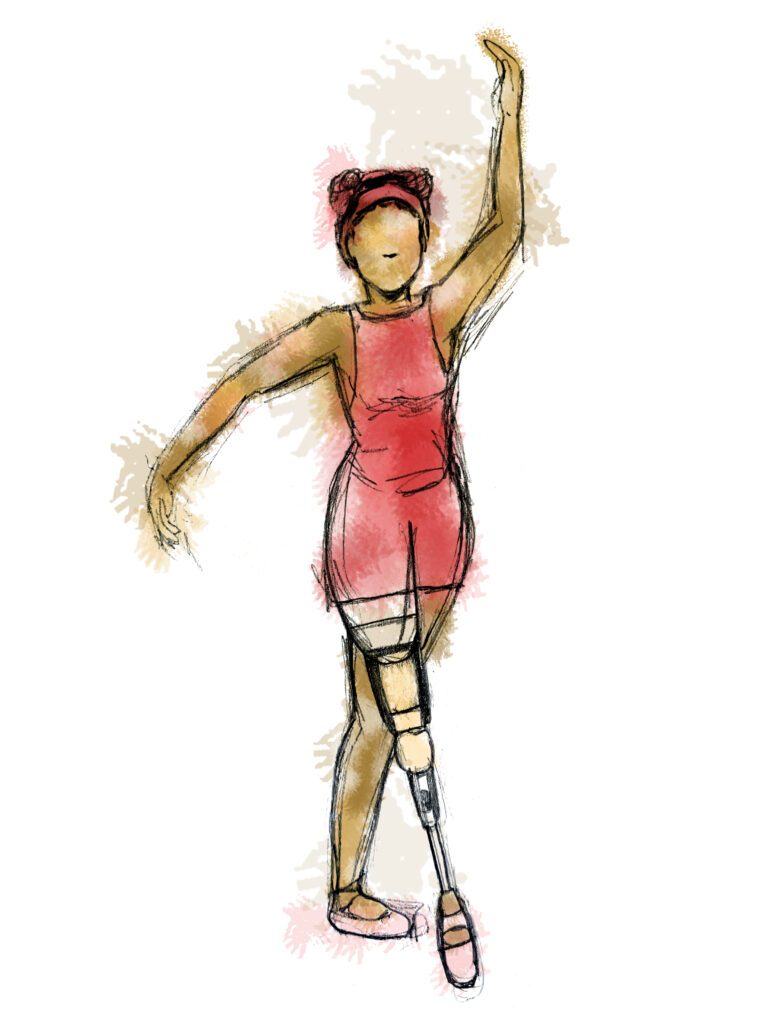
Image description: An illustration of a dancer with a prosthetic leg doing a tendu with one arm overhead.
What does “Considering Difference” consist of as of now?
We needed this information to be available beyond a written format. We already had a recorded video of our IADMS presentation that featured subtitles and British Sign Language translation, so that gave us one visual element that we knew was an important style of communication based on feedback we had received. Also, during one of our focus groups, participants fed back to us fairly unanimously that it would help people to understand the information if they could see how it was being explained, interpreted, felt, and experienced by the sector, so we decided to create a second video that took a ‘direct from the horse’s mouth’ approach and featured some of our external contributors speaking (or signing) to the issues described by the resource and their responses to the question, “Why is it important for us to consider difference in dance?” That was the second visual element, and what was particularly lovely about this was that it humanized the work and made it personable. It lifted it from being more than just a piece of writing and it made it real by putting faces and names to the project.
By the end of the final creation phase, we had the following:
- An Information Sheet PDF with a key-considerations and practical applications pull-out
- An easier-to-read version of the Information Sheet PDF
- A plain text version of the Information Sheet PDF
- The external contributor video resource
- The IADMS conference academic presentation video
- Our brilliant communications team was also able to not only house all of this on the One Dance UK website, but they also created a separate online space which enables the information sheet to be viewed with an accessibility plug-in, meaning that readers can alter screen-contrast, magnify text size, utilize a text-to-speech function, etc.
In total, we currently have six versions of the resource, and in the future there might be more.
How did you and your colleagues go about distilling two years of research into easy-to-access versions?
It was a real challenge because the last thing we wanted to do in creating an easier-to-read text was make it reductionist. Throughout the process, we had formal and semi formal interactions that all fed into this framework and informed what the outcomes looked like. In terms of going from research to versions like the easier-to-read PDF, it’s been hard to know if we’re getting it right. That’s why we sought so much external advice from specialists. It’s still part of the learning process for us and something we continue to look for feedback about as we grow the project. All we can do is put the resources out there and then hear from the sector on how they have or haven’t been useful. It poses questions about buy-in: It’s easier to get feedback from people who have already bought into the inclusive agenda than from people who are on the cusp. I hope that by having more than one output, we can reach those groups of people who we haven’t reached yet.
How has “Considering Difference” been received and implemented by the dance sector in the UK so far?
We are pleased to have received some really positive feedback, namely with regard to the design of the information sheet itself. We’re of course thrilled about this because of how much time and energy we as a team spent in doing our best to ensure that the design worked with and was appropriate for the content, from the color scheme to line-spacing and borders. In particular, we’ve received some great responses about the bullet-pointed pull-out table that sits at the back of the resource. That alone has taught us a lot about the power of listed information and its impact on readability. So not only have we been learning about how the content and findings have been beneficial to people but also how the way in which it has been presented matters.
People have also commented on how pleased they were to see a chunk of information about online access and digital poverty. This has been highlighted as a key issue as a result of COVID and the shift to digital engagement. It has taught us a lot about how niche dance-specific access issues can be inflated by wider UK socio-economic circumstances, as well as the importance people place on that being acknowledged and actioned.
Generally the work has been received with open arms by the sector, which we’re so grateful for, and as word travels around about “Considering Difference,” we’re receiving more and more invitations and opportunities to share about the project.
We really want people to know that the conversations don’t stop once they’ve finished reading the info sheet or watching the videos. We hope to promote discussion and spark conversation. The door is very much open in terms of feedback. We need feedback – positive, constructive, or otherwise – in order to keep improving the way in which we talk about and manage this area of work. Hopefully we’ll keep hearing from people about how they have been using the resources!
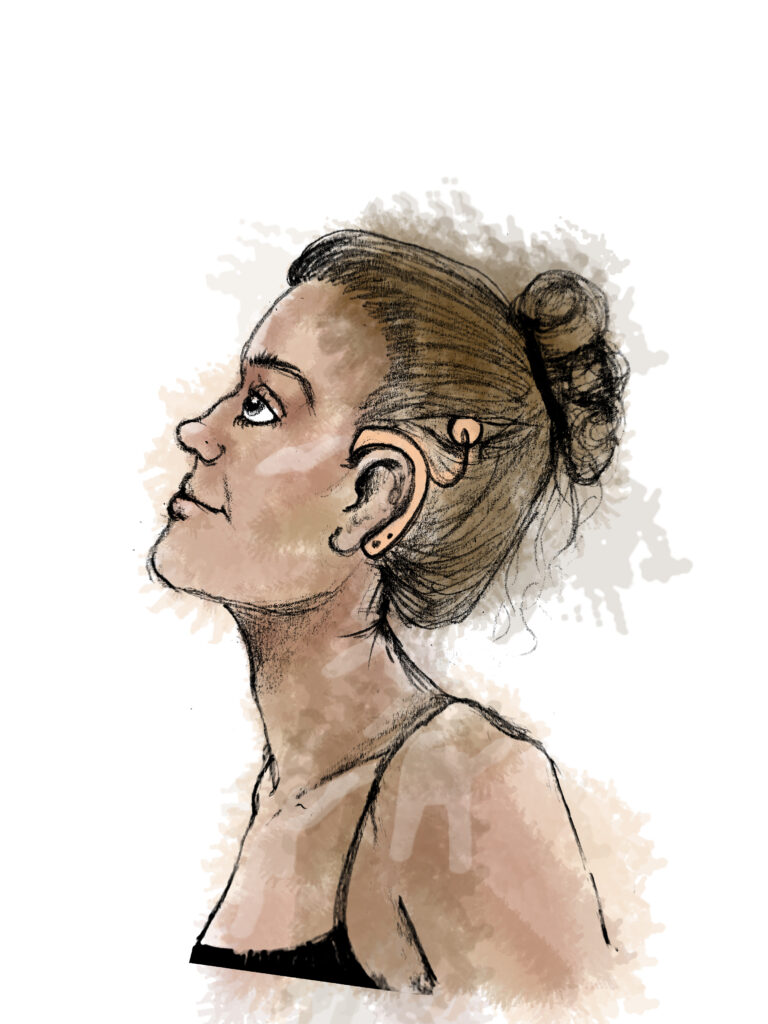
Image description: An illustration of a dancer wearing a hearing aid with their hair in a bun.
What are some personal take-aways or lessons you’ve learned while working on this project?
There are so many!
Talking about accommodating and considering difference can feel kind of clunky at times. I’ve learned that the more transparent and honest we are about how we feel in those conversations, the more we take away from them. During one of the participant interviews, I remember kind of fumbling over my words because I was nervous. I didn’t want to say the wrong thing, but I also didn’t want to feel afraid of trying to discuss this person’s access need openly and honestly. After all that’s why we were there. This person was so understanding. They said, “It’s less about what you actually say and more about your intention.” That really stuck with me, and I often think back to that moment with that person whenever I feel in doubt.
Another very personal takeaway I did not expect was to learn so much about my own neurodiversity along the way. It’s been so meaningful to share in those experiences with others. Talking to people who are and aren’t like me has been enriching and overwhelmingly exciting. It’s been great talking to other neurodiverse dance sector workers because there’s this mutual sympathetic exchange. But when talking to someone in our sector with whom I am completely seemingly dissimilar, in those conversations we practice and reciprocate empathy.
I think the biggest lesson that this project has taught me is the simple power of listening with an open-minded ear; each conversation that we’ve had has been like a brick in the “Considering Difference” structure. This year we might have built a bungalow, next year we might build a two-story detached, and in five years a mansion! I’m not sure if this is a helpful metaphor, but the way I see it now is that the more people who contribute a brick to the building, the more people can fit inside it!
Does One Dance UK have plans to continue working on “Considering Difference”? How would you like to expand this work in the future?
We do indeed! Over the course of developing this initial information sheet and its various versions, we came to realize early on that it would be naïve of us to think that we could squeeze all there is to know about difference and access into one resource. As a result, we’ve termed this first batch of work as “Considering Difference – Making Dance Accessible: An Introduction.” We want to think of it as an endeavor that can constantly evolve and respond as the sector continues to grow and change.
What we’re hoping for in the future is a second, third, fourth, and fifth batch of “Considering Difference” resource strands, each of which will dive a little deeper into a specific nuance or intersections of difference in dance. For instance, there might be an information packet of resources specific to neurodiversity in dance. There really is so much for us as an organization and more importantly as a united sector to collaboratively un-pick and work on together.
A long-term goal for “Considering Difference” would be to develop a more formalized set of best-practice guidelines and industry standards around access in dance, so we can really support the direct application of accommodating difference and eventually measure its impact relative to engagement and wellbeing.
Any other thoughts?
Having these conversations nationally and internationally are important. Along the process, we’ve reminded ourselves that we’re not trying to reinvent the wheel. So many fantastic organizations in the UK and beyond are doing such incredible work in this area. We want to use our platform in a way that not only promotes the ideas we have but also puts forward the fantastic work happening in other organizations. It’s about uniting and having more cross-collaborative discussions. That can happen internationally as well.
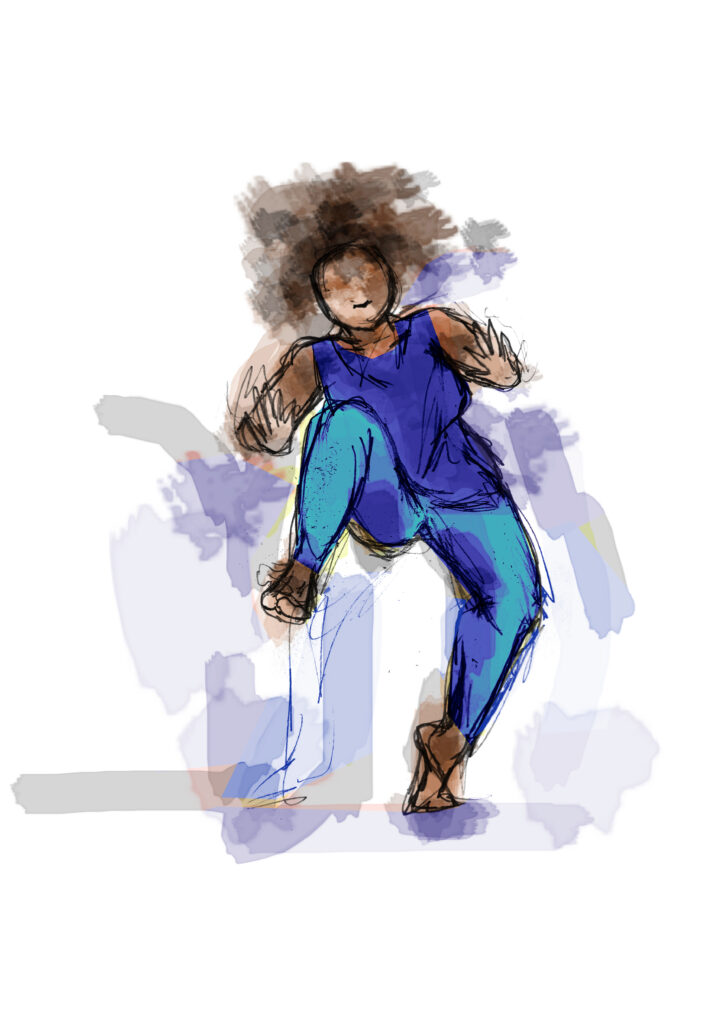
Image description: An illustration of a dancer with one leg lifted and arms bent with hands flat in front of them.
~~
To learn more about “Considering Difference – Making Dance Accessible,” visit www.onedanceuk.org/programme/healthier-dancer-programme/considering-differences
